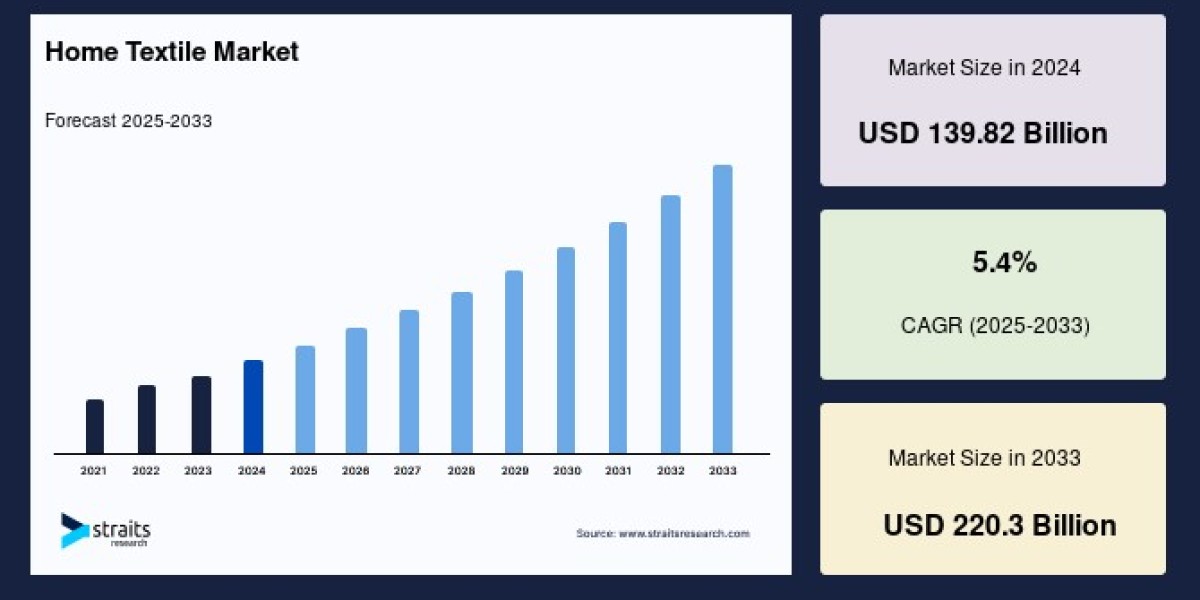The global home textile market size was valued at USD 139.82 billion in 2024 and is projected to grow from USD 146.47 billion in 2025 to USD 220.3 billion by 2033, with a CAGR of 5.4% during the forecast period (2025–2033).
Market Drivers and Consumer Trends
Increasing global urbanization and the rise of a middle-class population worldwide have substantially boosted demand for premium and customized home textile products. Consumers today prioritize comfort, aesthetics, and sustainability when selecting home furnishings. The growing awareness of eco-friendly products has encouraged manufacturers to innovate and adopt sustainable materials such as organic cotton, bamboo fibers, hemp, and recycled polyester. This shift towards green alternatives aligns with international environmental goals and consumer expectations, making sustainability a central influence on product development and brand positioning.
Technological advancements also play an important role in shaping market dynamics. The introduction of smart textiles fabric embedded with technology to regulate temperature, manage moisture, or monitor health-related metrics alongside digital textile printing, enables personalized and highly functional products. These innovations cater to consumers eager to embrace modern living spaces enhanced with technology while maintaining a focus on comfort and style.
Regional Insights
North America is a significant market, attributed to high consumer spending, strong retail infrastructure, and an established culture of valuing home décor. The United States leads regional demand with its emphasis on premium and sustainable home textiles, supported by an expanding e-commerce space that broadens product accessibility.
Asia Pacific is the fastest-growing region, accounting for about 45% of the global market share. Rapid urbanization in countries such as China, India, and Southeast Asian nations fuels demand, supported by growing disposable incomes and an expanding middle class. The region’s solid manufacturing base and advancements in textile technology position it as a global hub for home textile production, with e-commerce facilitating market penetration to previously underserved consumer segments.
Europe ranks as the third-largest market, featuring mature consumer preferences with a focus on quality, sustainable textiles, and ethical production practices. Strong regulatory frameworks in countries like Germany, France, and the UK encourage manufacturers to incorporate eco-friendly processes, helping reinforce the market’s sustainability-driven growth.
Product and Material Segmentation
Bedroom linen commands a significant share, approximately 35% of the global home textile market, owing to the essential role of items such as bedsheets, pillowcases, and duvets. Heightened urbanization, rising disposable incomes, and increased hospitality industry activity drive demand for premium bedroom textiles that emphasize sleep comfort and aesthetic appeal.
Cotton remains the preferred material, representing roughly 40% of the market. Its natural softness, breathability, and durability make it ideal for bedding and bath linens. The increased popularity of organic and sustainably sourced cotton aligns with the market’s shift toward environmentally responsible products.
Distribution Channels
Despite the rapid expansion of e-commerce platforms offering convenience and variety, offline retail channels continue to dominate, accounting for about 70% of market sales. Consumers prefer in-person evaluation of textile texture, color, and quality in physical stores such as department stores, specialty home furnishing outlets, and supermarkets. However, omnichannel strategies integrating online and offline shopping experiences are increasingly adopted to satisfy evolving consumer preferences and enhance service.
Challenges and Opportunities
The home textile industry faces challenges from fluctuating raw material prices, particularly cotton, wool, and synthetic fibers. External factors such as climate change and geopolitical tensions can disrupt supply chains and increase production costs, impacting pricing strategies and profit margins. Manufacturers mitigate these risks by adopting alternative raw materials like recycled fibers and developing agile sourcing models.
Opportunities lie in further technological integration, expanding smart textile applications, and continued investment in sustainable products. Waterless dyeing techniques, biodegradable fibers, and antimicrobial fabrics are examples of innovations combining performance with eco-consciousness. Brands prioritizing research and development, sustainability, and digital innovation are positioned to capture premium market segments and capitalize on evolving consumer trends.
Conclusion
The global home textile market is set for sustained growth fueled by rising incomes, urbanization, and heightened consumer focus on home comfort and environmental responsibility. Technological advancements and sustainability trends will continue to reshape product offerings and market strategies. Regions like Asia Pacific will drive expansion, supported by strong manufacturing capabilities and digital commerce platforms. Understanding evolving consumer demands and navigating supply chain complexities will be crucial for market players aiming to maintain competitiveness and foster innovation in this dynamic landscape.













